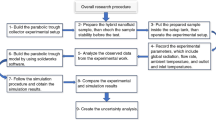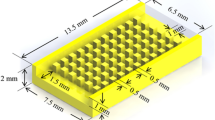Abstract
Renewable energies have a high impact on power energy production and reduction of environmental pollution worldwide, so high efforts have been made to improve renewable technologies and research about them. This paper presents the thermal performance results obtained by simulation and experimental tests of a parabolic trough collector with central receiver coupled to Fresnel lens, under different configurations on the pipe. The simulation method was computational fluid dynamics (CFD) analysis in Solid Works® soft-ware tool, which works with Naiver-Stokes equations to converge on a solution. Experimental tests were formed with all configurations proposed and three observations for each one, a total of 12 observations were performed in all research. As a result, the best thermal performance in simulation was achieved with the Fresnel lens and black pipe collector, with a maximum temperature of 116 °C under 1 000 W/m2 radiation, the same system achieved in experimental tests a maximum temperature of 96 °C with a radiation of 983 W/m2.
Similar content being viewed by others
References
H. El Ghor, M. Chetto. Energy guarantee scheme for real-time systems with energy harvesting constraints. International Journal of Automation and Computing, vol. 16, no. 3, pp. 354–368, 2019. DOI: 10.1007/s11633-018-1166-3.
G. Wang, Z. S. Chen, P. Hu, X. F. Cheng. Design and optical analysis of the band-focus Fresnel lens solar concentrator. Applied Thermal Engineering, vol. 102, pp. 695–700, 2016. DOI: 10.1016/j.applthermaleng.2016.04.030.
R. Grena. Optical simulation of a parabolic solar trough collector. International Journal of Sustainable Energy, vol. 29, no. 1, pp. 19–36, 2010. DOI: 10.1080/14786450903302808.
C. Tzivanidis, E. Bellos, D. Korres, K. A. Antonopoulos, G. Mitsopoulos. Thermal and optical efficiency investigation of a parabolic trough collector. Case Studies in Thermal Engineering, vol. 6, pp. 226–237, 2015. DOI: 10.1016/j.csite.2015.10.005.
A. A. Hachicha, I. Rodríguez, R. Capdevila, A. Oliva. Heat transfer analysis and numerical simulation of a parabolic trough solar collector. Applied Energy, vol. 111, pp. 581–592, 2013. DOI: 10.1016/j.apenergy.2013.04.067.
M. Li, C. M. Xu, X. Ji, P. Zhang, Q. F. Yu. A new study on the end loss effect for parabolic trough solar collectors. Energy, vol. 82, pp. 382–394, 2015. DOI: 10.1016/j.energy. 2015.01.048.
K. Vignarooban, X. H. Xu, A. Arvay, K. Hsu, A. M. Kannan. Heat transfer fluids for concentrating solar power systems-a review. Applied Energy, vol. 146, pp. 383–396, 2015. DOI: 10.1016/j.apenergy.2015.01.125.
Z. Y. Li, Z. Huang, W. Q. Tao. Three-dimensional numerical study on fully-developed mixed laminar convection in parabolic trough solar receiver tube. Energy, vol. 113, pp. 1288–1303, 2016. DOI: 10.1016/j.energy.2016.07.148.
H. El Ghor, E. M. Aggoune. Energy efficient scheduler of aperiodic jobs for real-time embedded systems. International Journal of Automation and Computing, pp. 1–11, 2016. DOI: 10.1007/s11633-016-0993-3.
R. López-Martín, L. Valenzuela. Optical efficiency measurement of solar receiver tubes: A testbed and case studies. Case Studies in Thermal Engineering, vol. 12, pp. 414–422, 2018. DOI: 10.1016/j.csite.2018.06.002.
N. Yeh. Analysis of spectrum distribution and optical losses under Fresnel lenses. Renewable and Sustainable Energy Reviews, vol. 14, no. 9, pp. 2926–2935, 2010. DOI: 10.1016/j.rser.2010.07.016.
F. Duerr, Y. Meuret, H. Thienpont. Miniaturization of Fresnel lenses for solar concentration: A quantitative investigation. Applied Optics, vol. 49, no. 12, pp. 2339–2346, 2010. DOI: 10.1364/AO.49.002339.
V. Kumar, R. L. Shrivastava, S. P. Untawale. Fresnel lens: A promising alternative of reflectors in concentrated solar power. Renewable and Sustainable Energy Reviews, vol. 44, pp. 376–390, 2015. DOI: 10.1016/j.rser.2014.12. 006.
P. J. Sonneveld, G. L. A. M. Swinkels, B. A. J. van Tuijl, H. J. J. Janssen, J. Campen, G. P. A. Bot. Performance of a concentrated photovoltaic energy system with static linar Fresnel lenses. Solar Energy, vol. 85, no. 3, pp. 432–442, 2011. DOI: 10.1016/j.solener.2010.12.001.
W. T. Xie, Y. J. Dai, R. Z. Wang. Theoretical and experimental analysis on efficiency factors and heat removal factors of Fresnel lens solar collector using different cavity receivers. Solar Energy, vol. 86, no. 9, pp. 2458–2471, 2012. DOI: 10.1016/j.solener.2012.05.017.
G. Q. Li, Y. Jin. Optical simulation and experimental verification of a Fresnel solar concentrator with a new hybrid second optical element. International Journal of Photoenergy, Article number 4970256, 2016. DOI: 10.1155/2016/4970256.
H. Zhai, Y. J. Dai, J. Y. Wu, R. Z. Wang, L. Y. Zhang. Experimental investigation and analysis on a concentrating solar collector using linear Fresnellens. Energy Conversion and Management, vol. 51, no. 1, pp. 48–55, 2010. DOI: 10.1016/j.enconman.2009.08.018.
M. Lin, K. Sumathy, Y. J. Dai, X. K. Zhao. Performance investigation on a linear Fresnel lens solar collector using cavity receiver. Solar Energy, vol. 107, pp. 50–62, 2014. DOI: 10.1016/j.solener.2014.05.026.
I. Soriga, C. Neaga. Thermal analysis of a linear fresnel lens solar collector with black body cavity receiver. Scientific Bulletin, Series D/; Mechanical Engineering, vol. 74, no. 4, pp. 105–116, 2012.
X. L. Li, H. W. Chang, C. Duan, Y. Zheng, S. M. Shu. Thermal performance analysis of a novel linear cavity receiver for parabolic trough solar collectors. Applied Energy, vol. 237, pp. 431–439, 2019. DOI: 10.1016/j.apenergy. 2019.01.014.
H. Wang, J. Huang, M. J. Song, J. Yan. Effects of receiver parameters on the optical performance of a fixed-focus Fresnel lens solar concentrator/cavity receiver system in solar cooker. Applied Energy, vol. 237, pp. 70–82, 2019. DOI: 10.1016/j.apenergy.2018.12.092.
S. Perini, X. Tonnellier, P. King, C. Sansom. Theoretical and experimental analysis of an innovative dual-axis tracking linear Fresnel lenses concentrated solar thermal collector. Solar Energy, vol. 153, pp. 679–690, 2017. DOI: 10.1016/j.solener.2017.06.010.
R. Leutz, A. Suzuki, A. Akisawa, T. Kashiwagi. Developments and designs of solar engineering Fresnel lenses. Proceedings Symposium on Energy Engineering, vol. 2, pp. 759–765, 2000.
R. Leutz, A. Suzuki. Nonimaging Fresnel Lenses: Design and Performance of Solar Concentrators, Berlin, Germany: Springer, 2001.
R. Foster, M. Ghassemi, A. Cota. Solar Energy: Renewable Energy and the Environment, Boca Raton, USA: CRC Press, 2009.
T. T. Pham, N. H. Vu, S. Shin. Novel design of primary optical elements based on a linear fresnel lens for concentrator photovoltaic technology. Energies, vol. 12, no. 7, Article number 1209, 2019. DOI: 10.3390/en12071209.
H. L. Huang, Y. H. Su, Y. B. Gao, S. Riffat. Design analysis of a Fresnel lens concentrating PV cell. International Journal of Low-Carbon Technologies, vol. 6, no. 3, pp. 165–170, 2011. DOI: 10.1093/ijlct/ctr002.
N. Yeh, P. Yeh. Analysis of point-focused, non-imaging Fresnel lenses′ concentration profile and manufacture parameters. Renewable Energy, vol. 85, pp. 514–523, 2016. DOI: 10.1016/j.renene.2015.06.057.
Acknowledgment
This paper supported by Research Vice Rectory of Universidad Militar Nueva Granada-validity, Colombia in 2019 (No. IMP-ING-2656).
Author information
Authors and Affiliations
Corresponding author
Additional information
Recommended by Associate Editor Jie Zhang
Angelica Palacios received the B. Sc. degree in mechatronic engineering, and the M. Sc. degree in project management from Military University, Colombia (UMNG) in 2015 and 2019, respectively. Currently, she is a Ph. D. degree candidate in applied science at the Research Group GAV (Virtual Applications Group), Military University, Colombia and she is also working as a research assistant in the field of sustainable energy and renewable energies at GAV, Colombia.
Her research interests include renewable energy, optimization systems, thermodynamics, solar collector and solar energy.
Dario Amaya received the B. Sc. degree in electronics engineering from Antonio Narino University, Colombia in 1995, and the M. Sc. degree in teleinformaticin from Faculty of Engineering, District University Francisco Jose de Caldas, Colombia in 2007. He received the Ph. D. degree in mechanical engineering from Campinas State University, Brazil in 2011, working on hybrid control. He has worked as a professor and a researcher at the Military University, Colombia since 2007. He has been involved in robotics, mechatronics and automation areas.
His research interests include robotics, mechatornics and industrial automation.
Olga Ramos receiving the B. Sc. degree in electronics engineering from Antonio Narino University (UAN), Colombia in 1998. She obtained her specialization certificate in electronic instrumentation at UAN, Colombia in 2000, and received the M. Sc. degree in teleinformatics from Faculty of Engineering, District University Francisco Jose de Caldas (UFJC), Colombia in 2007. She received the Ph. D. degree in engineering at District University Francisco Jose de Caldas, Colombia in 2017. Currently, she is a Ph. D. degree candidate in engineering at UFCJ, Colombia. Right now, she is working as a teacher atUMNG and as researcher in GAV in different mechatronics fields like system control and industrial automation.
Her research interests include control systems and industrial automation.
Rights and permissions
About this article
Cite this article
Palacios, A., Amaya, D. & Ramos, O. Parabolic Trough Collector and Central Receiver Coupled with Fresnel Lens: Experimental Tests. Int. J. Autom. Comput. 17, 572–587 (2020). https://doi.org/10.1007/s11633-019-1220-9
Received:
Accepted:
Published:
Issue Date:
DOI: https://doi.org/10.1007/s11633-019-1220-9




